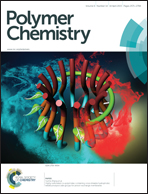Highly sulfonated co-polyimides containing cross-linkable hydrophobic tetrafluorostyrol side-groups for proton exchange membranes†
Abstract
A series of novel highly sulfonated co-polyimides (SPI-20s) bearing cross-linkable hydrophobic tetrafluorostyrol side-groups have been successfully synthesized. The cross-linking reaction of the tetrafluorostyrol groups in the SPI-20s was performed at 260 °C without any additive. The glass transition temperatures of the cross-linked membranes were determined by differential scanning calorimetry and dynamic mechanical analysis and found to be higher than the SPI-20s proving the formation of cross-linked networks. There was no elimination of sulfonic acid groups during cross-linking reaction. The cross-linked membranes (Cured-SPI-20s) showed significantly enhanced performances, particularly high proton conductivity (0.103–0.179 S cm−1 at 80 °C), low water uptake (31.2–53% at 80 °C) and swelling ratio (6.4–14.1% at 80 °C). Furthermore, the Cured-SPI-20s exhibited a greatly reduced methanol permeability (3.99–4.93 × 10−7 cm2 s−1), which was lower than that of Nafion 117 (2.94 × 10−6 cm2 s−1) at room temperature. The Cured-SPI-20 membranes also exhibited improved glass transition temperatures (254–277 °C), thermal stability (5% weight loss temperature exceed at 300 °C) and excellent oxidative stability, chemical resistance and mechanical properties. The results indicate that the Cured-SPI-20s were promising candidates as proton exchange membranes in fuel cell technology.


 Please wait while we load your content...
Please wait while we load your content...